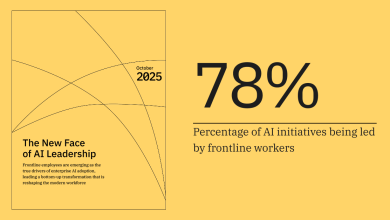
Advances in artificial intelligence (AI) and automation have given rise to the next-generation digital workforce in healthcare revenue cycle management (RCM): Agentic AI.
The value of agentic AI, and other forms of digital agents, is not only their ability to accelerate task completion with greater accuracy but also to accomplish judgment and logic-driven tasks usually reserved for humans. Claim follow-ups, denial prevention, eligibility verification, data and payment reconciliation, and patient financial engagement are all high-complexity tasks requiring nuanced human judgment that are ideal for agentic AI. Digital agents also help ease the burden on RCM teams, which are already stretched thinly due to chronic workforce shortages.
To derive optimal value and rapid return-on-investment (ROI) from a digital workforce, it is crucial to understand what they are and how they work. Following a set of best practices gleaned from early adopters is also essential to ensure the digital workforce is positioned for acceptance and success.
The Rise of the Digital Agent
The term “agentic” emphasizes the digital agent’s capacity for agency, specifically its ability to act purposefully and independently and exhibit autonomy, goal-driven behavior, and adaptability. Digital agents are designed to work with, not around, RCM professionals. They understand natural language, adapt to changing rules and workflows, and make autonomous decisions to achieve tangible business outcomes, such as reducing denials and increasing clean claim rates. Importantly, they learn from these outcomes to improve their capabilities and accuracy over time.
That adaptability sets AI agents apart from robotic process automation (RPA), which is a point solution with limited repeatability and scalability and sometimes ossifying the already inefficient process flow. Where RPA solutions, also referred to as bots, are rules-based and best suited for tasks that do not require complex logic or reasoning, AI-powered digital agents incorporate various advanced AI-driven technologies and real-time analytics to manage complex RCM workflows with minimal human intervention. This enables them to replicate how humans comprehend workflows, make decisions based on context, and handle exceptions. They represent a shift in perspective from siloed parameters to integrated decision-making within a single intelligent system.
The new breed of AI agents have the potential to deliver a scalable, flexible, collaborative, cost-effective, and outcomes-driven workforce that can empower RCM teams and transforms the revenue cycle for improved financial performance.
Building and Orchestrating an AI-driven Workforce
An AI workforce represents a human-in-the-loop (HITL) system design comprised of autonomous AI agents that work alongside human counterparts to perform processes, tasks, and operations. The AI agents that make up this next-generation workforce are purpose-built to execute tasks, make decisions, or interact with users and other systems autonomously or semi-autonomously through digital interfaces.
AI agents simulate human behavior and deliver services efficiently by leveraging a wide variety of technologies. These include generative artificial intelligence (GenAI), machine learning (ML), large language models (LLMs), natural language processing and understanding (NLP/NLU), advanced reasoning engines, and RPA.
In healthcare RCM, AI agents are increasingly able to handle denial appeals, monitor payer rules for changes, adjust workflows, and coordinate with other digital and human agents to manage end-to-end billing processes. As a result, AI agents have the potential to deliver significant value, including:
- Accelerated turnaround times
- Faster collections
- Reduced denial rates
- Improved accuracy
- Increased staff productivity
They allow healthcare organizations to operate with best-in-class margins even as market pressure, driven by rising denial rates and regulatory scrutiny, increases. This, in turn, enables healthcare teams to focus on what they do best: patient care.
Where to Automate
Technology investments are appropriate when they translate to better financial outcomes and operational efficiency. With healthcare organizations reporting implementation of agentic AI systems driving a 63% reduction in time spent on initial claim reviews, from an average of 15 minutes to as little as five minutes, and a 30% increase in recovery rates, as well as lower administrative costs, greater claim accuracy, and lower error rates, a digital workforce passes that critical test.
Realizing this value starts by determining which forms of digital agents are the best fit for an organization’s RCM workflows. Doing so begins with identifying those RCM processes that are high-volume, time-sensitive, low-complexity, and have predictable decision trees. The initial focus of a digital workforce should center on simple tasks, such as eligibility checks, claims status, and standard denial workflows. More complex tasks and those requiring human interactions should be left to the human agents to give digital workers time to “learn” as they manage low-complexity processes.
Also essential is a clear vision of AI agents’ future role in the RCM workforce to ensure they can acquire the necessary knowledge and experience to enhance their capabilities. Over time, digital agents will learn to manage tasks with increased complexity and effectively complete more expanded workflows as more results and data come in and feedback loops improve.
Finally, choosing the right technology partner is crucial to building an effective AI RCM workforce. Along with deep industry experience in both RCM and technology, the ideal partner should possess deep knowledge of RCM complexities, proven AI and automation capabilities, and a collaborative implementation model. Also, avoid partners that offer only siloed technology or industry knowledge. A successful AI workforce lives at the intersection of both.
Access is Power
Before implementation, prepare the RCM team and workflows for deployment. First, determine what data the development team or partner can access and whether secure access can be obtained for systems, documentation, and/or portals. This information is crucial, as a successful implementation depends on transparent data sharing and development resources that can be trusted with the organization’s system environment.
These answers will also guide the next phase, which is ensuring that data is AI-ready. Within many healthcare organizations, critical data continues to reside in silos, including electronic health records (EHRs), billing systems, analytics dashboards, and third-party providers. In this fragmented state, data is neither AI-friendly nor capable of “communicating” with digital agents. There is also rarely any form of data governance guiding its use.
Digital agents both analyze and act; therefore, data must be ready to support autonomous decision-making, real-time feedback loops, and continuous learning. Clean, contextual, and connected data is required for goal-driven AI agents to execute tasks autonomously and effectively while learning from outcomes and adapting over time.
Thus, preparing data for a digital workforce requires data to be cleaned and normalized so it can be trusted. This includes:
- Standardizing formats across EHR, billing, and payer systems.
- De-duplicating patient and provider records.
- Resolving any missing fields (e.g., CPT codes, payer IDs, denial reasons).
- Mapping legacy codes to modern taxonomies.
To help AI workers understand context and intent, the development team should tag data by specific RCM stages (e.g., prior authorization, coding, billing, and appeals), define decision points and outcomes, and use event logs to track actions and consequences for feedback loops.
Autonomous systems require oversight, which can be achieved by establishing governance and guardrails through role-based permissions, defined escalation paths, and logging all AI actions for auditability. Set confidence thresholds for autonomous vs. HITL decisions and ensure compliance with HIPAA and payer-specific rules.
Finally, engage internal security teams early in the process, clearly define objectives and current processes, and take the time to identify and engage with the right technology and data partners.
Following this phased approach, a minimum viable product use case can go live in four to eight weeks. Full deployment scales within three to six months, depending on the complexity of the environment, the selected use case, and system integrations. Agentic systems require less rigid configuration than traditional RPA, so deployment cycles are often faster and more adaptable.
Applications in RCM Today
Digital agents excel across a wide variety of repeatable RCM workflows. One promising area is accounts receivable (A/R), where digital agents are already being used to triage cases, diverting the most complex, high-dollar accounts to more experienced human agents while simpler ones are handled autonomously by agents.
AI agents are also being developed to manage phone calls with insurance payers. These digital agents can navigate phone menus, input claim identification numbers, and wait on hold until a payer representative answers. The agent can then connect to a human agent to complete the call. In some cases, especially with straightforward A/R calls involving low-dollar amounts, AI agents can handle the entire call, gathering the required answers and updating the EHR. Other examples of applications that are well-suited for digital workers include:
- High-volume, low-dollar claims
- Checking claim statuses
- Routing denials
- Prior authorization follow-ups
- Packaging and submitting appeals
- Interacting with payer portals
Embracing a Collaborative Hybrid Intelligence Model
Human intervention is essential in a AI workforce model, the ideal version of which combines the judgment and empathy of human agents with the speed, scalability, and adaptability of AI agents. It is a synergistic model where digital agents learn from outcomes to improve future decisions, and human agents provide feedback to retrain AI models and refine workflows.
In other words, humans are not absent from the digital workforce. Rather, their roles evolve. Digital agents handle the volume while human agents handle the variance. Together, they operate in a tiered system where AI agents manage structured tasks quickly and precisely while human agents step in when nuance, judgment, or external coordination is needed. For example:
- Claims submission: AI agents assemble clean claims, validate against payer rules, and submit electronically. Human agents review claims flagged for anomalies or high-dollar thresholds before submitting them.
- Denial management: AI agents analyze denial trends, draft appeal letters, and resubmit corrected claims. Humans tackle complex appeals, negotiate with payers, and escalate systemic issues.
- Payments and collections: AI agents match remits to claims, post payments, and initiate patient billing workflows. Human agents work with patients on payment plans, resolve disputes, and manage charity care cases.
Other processes where AI and human agents collaborate include payer phone calls, escalations, or ambiguous documentation or data.
This human-technology collaboration improves throughput without sacrificing quality. AI agents prep the work, flag exceptions, surface insights, and suggest potential next-best actions so humans can make smarter, faster decisions. Put simply, an effective digital workforce incorporates man with machine—not man against machine.
Change Management Best Practices
Integrating a AI workforce into RCM won’t succeed based solely on technology. Success requires team buy-in, planning, and communication. The following best practices will drive adoption and long-term success:
- Early stakeholder engagement: Include operations, IT, and compliance teams from the start.
- Clear communication: Explain what is changing and why automation is being implemented.
- Incremental rollout: Start small, show wins, and scale with confidence.
- Training and support: Prepare teams for their evolving roles, especially in quality assurance, exception handling, and oversight.
- Feedback loops: Establish regular forums to share results, surface concerns, and refine agent behavior based on real-world outcomes.
- Link to ROI: Tie initiatives to ROI, because without it, buy-in, technology, and solutions don’t matter.
Finally, have shorter innovation paths and proceed with humility. Agentic automation is a powerful yet continuously evolving form of workforce innovation. Focus on the art of the possible with practical, attainable solutions. If something doesn’t work, move on and revisit later when AI capabilities have further matured.
Avoiding Common Pitfalls
There are several common pitfalls to designing and deploying a digital workforce that, if not avoided, could doom it to fail from the outset. One of the most significant is failing to establish adequate feedback loops, which hinders AI agents from accessing the performance feedback required for them to learn and adapt.
Over-automation is another pitfall. Automating complex tasks too soon can backfire, as digital agents are not yet equipped to manage them. Instead, start with high-impact cases where digital agents can deliver rapid ROI, such as denial management, medical coding, prior authorization, and eligibility verification.
Finally, failing to eliminate siloed data in the first phase. Inaccessible or incomplete data will limit outcomes. Remember, digital agents are only as intelligent as the data they are trained on and the results that are fed into the system.
Ensuring Long-Term Success
Measuring the success of a digital RCM workforce is crucial, not only for performance tracking but also for fostering trust, ensuring safety, and driving continuous improvement. Unlike traditional automation, agentic AI systems make autonomous decisions, adapt to feedback, and operate in complex, high-stakes environments like RCM, meaning success must be measured based on outcomes and processes.
Hospitals must trust that digital agents can make safe, compliant decisions, acting within defined boundaries, and providing clear, explainable reasoning for audits and oversight. Furthermore, some digital agents not only complete tasks but also reason, plan, and adapt. Thus, it is essential to evaluate:
- Task Adherence: Did the agent fulfill the user’s intent?
- Tool Use Accuracy: Did it use the right systems (e.g., payer portals, EHR)?
- Intent Resolution: Did it understand and act on the correct goal?
While traditional RCM metrics—appeal success rate, denial rate, time-to-collect, cost-to-collect, and dollars recovered or protected—remain relevant with a digital workforce, an added layer is required to measure autonomy, accuracy, and robustness. This includes the percentage of tasks completed without human intervention, correct code selection, valid tool utilization, and performance under exceptions.
It is also crucial to measure the performance of the feedback loops that are essential for model retraining and prompt refinement. Metrics that measure how well these performance loops help digital agents to learn over time include:
- What worked (e.g., successful appeal language)
- What failed (e.g., incorrect denial categorization)
- Why it failed (e.g., outdated payer rule, missing data)
Leveraging these KPIs will help ensure continuous improvement of the digital workforce by providing outcomes data to refine agent rules and identify and prioritize new automation opportunities. They also set the stage for using AI-generated insights to refine workflows and training data, including regularly retraining models with new payer rules and outcomes.
The Future of Agentic Automation in Healthcare
The future of agentic automation is intelligent, adaptive, and deeply integrated. Agents won’t just follow rules; they will evolve with the business, learning from outcomes, aligning with payer changes, and adapting to new workflows in near-real time.
Provider organizations will realize numerous benefits when their financial leaders embrace the shift to properly designed and deployed agentic digital workforces. In addition to unlocking scalable, round-the-clock operations, a digital workforce can reduce cost pressures without sacrificing quality, reassigning human talent to higher-value work. This enables the creation of a future-ready infrastructure that is primed for innovation.
Waiting means falling behind. Agentic automation is already here. The leaders who adopt it today will be the ones who shape how care gets paid for tomorrow.




